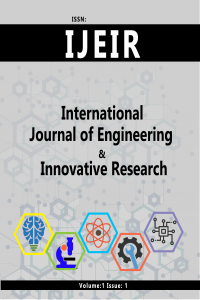Desıgn and Constructıon of an Automated and Manual New-Fangled Fruıt Juıce Extractor
Desıgn and Constructıon of an Automated and Manual New-Fangled Fruıt Juıce Extractor
The goal of this study was to design and build an automatic and manual new-fangled fruit juice extractor. People's growing desire for fruit juice, owing to its nutritional benefits, has resulted in the development of a machine that would make the extraction of huge quantities of fruit juice easier and more efficient. The ideal operating criteria for the new-fangled juice extraction machine, juice yield, extraction loss, and extraction efficiency, were assessed for performance throughout the design phase. The entire production capacity of new-fangled juice extraction machines, both automated and manual, was also assessed. The machine was built manually with the use of local materials and tools. The major materials used for the construction of the machine were mld steel, stainless steel, and plastic. During the construction of the machine, the component pieces were fabricated separately using mld steel sheet, stainless steel, and plastic before being finally assembled. It was built in such a way that when the handle is moved, the fruits are crushed and juice is produced. It was also built to run automatically thanks to the incorporation of a drive belt and an electric motor. The orange and citrus fruits were washed and weighed in this study, with fruit weights ranging from 1.4kg to 2.5kg. Maximum juice output, extraction efficiency, and extraction loss were all determined to be 77.6%, 85.3%, and 6.5 percent, respectively.The results demonstrate that the newly planned and manufactured juice extractor performed well in terms of juice extraction capacity.
___
- [1]Akin E, Evrendilek G.A (2009). Effect of pulsed electric fields on physical, chemical and microbiological properties of formulated carrot juice. Food Sci Technol Int 15:275-282 [2] Oluwalana, I.B (2011). Fruit cultivation and processing improvement in Nigeria. Agriculture journal 5(2): 307-310
- [3] Eyeowa et al.(2017). Design, fabrication and testing of a manual juice extractor of small scale applications. Current Journal of Applied Science and Technology 22(5):1-7.
- [4] Ballinas-Casarrubias ML, Nevarez-Moorillon GV, Martin-Belloso O, Ortega-Rivas E (2007) Thermal and pulsed electric fields pasteurization of apple juice: effects on physicochemical properties and flavour compounds. Journal of Food Engineering. 83(1):41–46
- [5] Deck, JF; Dubowsky, S. (1994). “On the limitations of predictions of the dynamic response of machines with clearance connections,” Journal of Mechanical Design, 116 (3), pp. 21-41.
- [6]Badmus GA, Adeyemi NA (2004) Design and fabrication of a small scale whole pineapple fruit juice extractor. Proc 5th Int Conf and 26th Annual General Meeting of the Nigerian Institution of Agricultural Engineers 26:285–291
- [7]Ishiwu CN, Oluka SI (2004) Development and performance evaluation of a juice extractor. Proc 5th Int Conf and 26th AnnualGeneral Meeting of the Nigerian Institution of Agricultural Engineers 26:391–395
- [8] Ibhadode Akii, A. Introduction to Manufacturing Technology, Ambik Press, Benin City, Edo State, Nigeria, 2001.
- [9]Holdren, RD; Harris, WL; Burkhart, GJ (1997). “Squeezing Juice from Forage”. Transaction of the ASAE vol. 15(6): p. 1044-1048
- [10] Khurmi, RS; Gupta JK (2005). ”Text book on Machine Design”, Eurasia Publishing House, New Delhi.
- Yayın Aralığı: Yılda 3 Sayı
- Başlangıç: 2018
- Yayıncı: Ahmet Ali SÜZEN
Sayıdaki Diğer Makaleler
HYDROGEOLOGICAL AND HYDROGEOCHEMICAL INVESTIGATION OF ILICA (BALIKESIR) GEOTHERMAL FIELD
Murat KODALOĞLU, Feyza AKARSLAN, Ali İhsan KODALOĞLU
Desıgn and Constructıon of an Automated and Manual New-Fangled Fruıt Juıce Extractor
INTERACTION BETWEEN AQUATIC BIVALVE SPECIES AND GLOBAL CLIMATE CHANGE
Pınar YILDIRIM, Ertan ERCAN, Ergi BAHRİOĞLU
